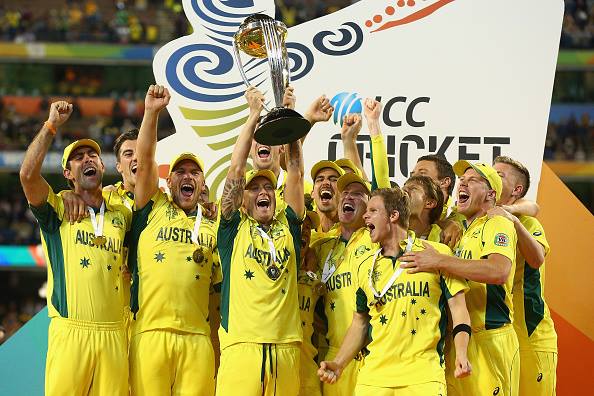India vs Australia: The rivalry of Goliath vs Goliath

“Ricky Ponting has a spring in his bat, mother,” complained Indian kids and grown-ups alike after that fateful evening in 2003. Riding on what was arguably the best innings in a World cup final till date, Australia went on to lift the trophy 13 years back. Countless did believe in that spring-in-his-bat theory and consoled
Australia

A rematch of the lopsided 2003 final, this time on Indian soil, left cricket fans smacking their lips. But after another Ponting century had taken Australia to a formidable 260 on the day, lip-smacking soon turned to finger-crossing for the Indian fan. The worst was feared. Will lightning strike twice?
Not to be, as half-centuries from Sachin, Gambhir and Yuvraj took India to a win. India went on to lift the cup after 28 years in Mumbai, and the nation of a billion took to the streets celebrating. “Two more to catch Australia,” roared an Indian fan on national television when asked how the win felt. Australia
But in four years time, two became three, as Australia won back the cup in Australia having conquered India in the semis. That’s how the India-Australia World Cup rivalry has been in the past 15 years in the limited overs formats. The 2003 loss
Jack Ryder, a 46-year old veteran toured the Indian subcontinent in late 1935 with his second-rate Australian side. India were minnows and Australia saw no point in sending their first team, who were in South Africa playing a Test series. In what was a four-month tour, Australia played India in four Test matches at Madras, Kolkata, Lahore and Bombay. The series ended 2-2 but will be unavailable in most history books. Reason? This was an unofficial series. The first official meeting between the two sides took place 12 years later when India visited Australia to play a five-match series. Australia won 4-0.
More tours followed to and fro, but one thing remained constant - an Australia series win. But the trend was to change in
Test matches had a new sibling in town by then, in the form of limited overs cricket, and West Indies were the undisputed kings, winning the first two World cups in dominant fashion. In search of a hat-trick, the Caribbean boys faced India in the final, in 1983. And lost. Kapil Dev hoisted the trophy at Lord’s to write India’s name in stone among the big boys of cricket.
But India’s ascent and rise to relevance in cricket didn’t affect Australia so much. With the World Cup moving outside England for the first time, Allan Border and his troops became champions in India, matching India’s tally. They went one-up 12 years later in
Named after the only two men to have scored 10000+ test runs back then, the Test match rivalry started to take shape with a bigger prize at stake. India had come a long way from being pushovers to challengers, and on this occasion had turned winners. India won the inaugural Border-Gavaskar trophy in a one-off test in Delhi. Two years later, they retained their prized possession, winning the series 2-1, again at home. Sachin Tendulkar was man-of-the-series, and this is where things started to get really enticing.
Shane Warne was the best spinner in the world. Sachin Tendulkar was the best batsman in the world. Their contest was one for the generations, and large crowds turned up to see what the two maestros had in store for each other. While Warne dismissed Sachin in the first innings of the first Test, Tendulkar was in demolition mode in the second innings and guided India to a win with his unbeaten 155. While the Indian leg belonged to Sachin and India, the Australian leg went Australia’s way. In the Australian summer of 1999, India travelled down under, hoping to hold on to the Border-Gavaskar trophy(B-G trophy). By the time they left the Australian shores, they had not only surrendered the trophy but also got whitewashed 3-0.
In what was a very intriguing contest, India
Australia had a thumping win in the first test, winning by 10 wickets. The Indian team back then was weakened by the absence of Anil Kumble, and the bowling looked weak on paper and there were fears the second Test could seal the series for Australia. With the visitors rollicking at 252/4, it already started to look grim for the Indians. But a 21-year old Jalandhar boy had other plans. Three balls later, Harbhajan Singh became the first Indian bowler to take a hat-trick in Test cricket. That did not stop Australia from scoring 445. And when the Indians got packed up for a feeble 171, Australia enforced
Australia, not ones to forget a humiliation, served one back to India in the 2003 World Cup and that is where the rivalry
For whatever the two teams go on to achieve, they know they have to cross each other and conquer the other to secure the crown. That’s exactly what it’s going to be like on Sunday. In what is a quarter-final of sorts, India will take on Australia again to add another chapter to this fairytale of a rivalry. The winner moves to the last 4, the loser walks out. Australia, for all their dominance over the past 15-20 years in cricket,
There can be no love lost here. Steve Smith, the heir who got groomed for the role, versus Mahendra Singh Dhoni, who was never really the first choice for captaincy. Maxwell versus Kohli. The retiring Watson versus the should-be-retiring Yuvraj. For everything Australia have up their sleeve, India can throw one better. Except maybe the number of all-rounders. But that’s not going to matter. This India side has

Comments
Sign up or log in to your account to leave comments and reactions
0 Comments